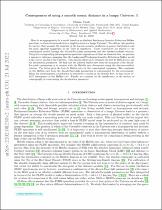| dc.contributor.author | Umeh, Obinna | |
| dc.date.accessioned | 2022-08-30T12:30:43Z | |
| dc.date.available | 2022-08-30T12:30:43Z | |
| dc.date.issued | 2022 | |
| dc.identifier.citation | Umeh, O. et al. (2022). Consequences of using a smooth cosmic distance in a lumpy Universe. I. Physical Review D, 106(2), 023514. 10.1103/PhysRevD.106.023514 | en_US |
| dc.identifier.issn | 2470-0029 | |
| dc.identifier.uri | 10.1103/PhysRevD.106.023514 | |
| dc.identifier.uri | http://hdl.handle.net/10566/7784 | |
| dc.description.abstract | How do we appropriately fit a model based on an idealised Friedmann-Lemaˆıtre Robertson-Walker
spacetime to observations made from a single location in a lumpy Universe? We address this question
for surveys that measure the imprints of the baryon acoustic oscillation in galaxy distribution and
the peak apparent magnitude of the Type Ia supernova. These observables are related to the
cosmological model through the Alcock-Paczy´nski parameters and the distance-redshift relation.
Using the corresponding inhomogeneous spacetime expressions of these as observed data, we perform
a parameter inference assuming that the background Friedmann-Lemaˆıtre Robertson-Walker model
is the correct model of the Universe. This process allows us to estimate the best fit Hubble rate and
the deceleration parameter. We find that the inferred Hubble rate from the monopole of the AlcockPaczy´nski parameters is in tension with the Hubble rate determined using the distance-redshift
relation. | en_US |
| dc.language.iso | en | en_US |
| dc.publisher | American Physical Society | en_US |
| dc.subject | Cosmology | en_US |
| dc.subject | Nongalactic Astrophysics | en_US |
| dc.subject | Astronomy | en_US |
| dc.subject | Astrophysics | en_US |
| dc.title | Consequences of using a smooth cosmic distance in a lumpy Universe. I. | en_US |
| dc.type | Article | en_US |

